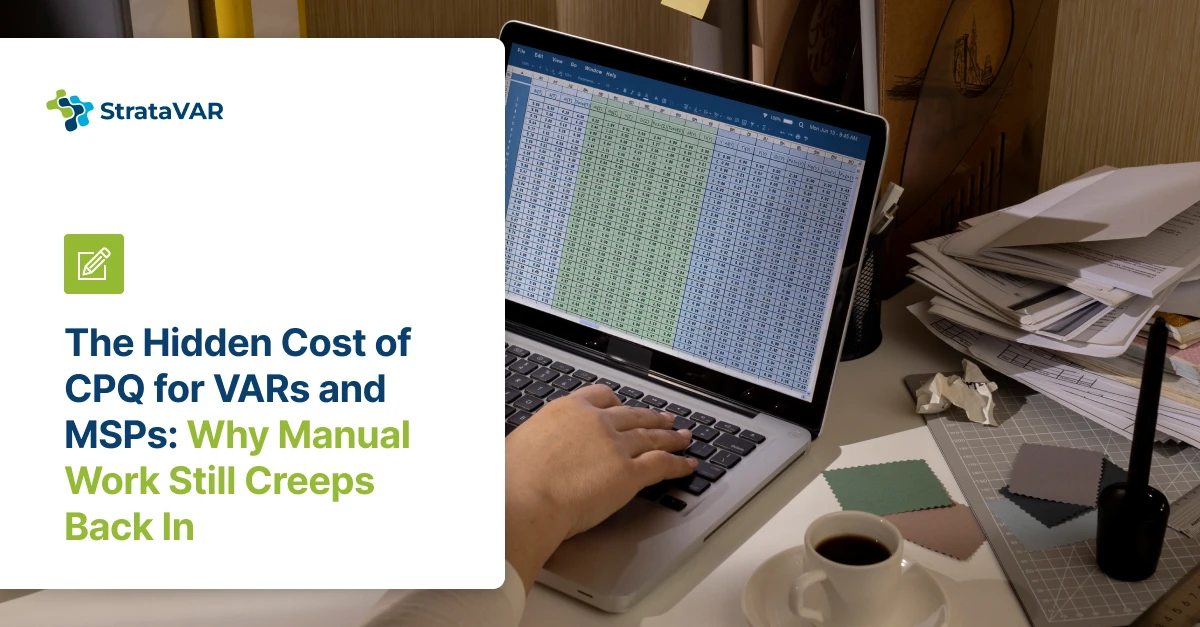Cisco’s CCW Quoting Integration Benefits: The Top 5 Advantages of an Integrated Quoting Process

This is a div block with a Webflow interaction that will be triggered when the heading is in the view.
This is a div block with a Webflow interaction that will be triggered when the heading is in the view.
As ICT VARs are all aware, managing the quoting process efficiently is crucial for staying competitive. However, many of the cost sources that today’s ICT VARs and Cisco Partners rely on are scattered across different systems. This makes it difficult for VARs to create accurate quotes without proper CCW integration.
Without a centralized platform, teams often spend hours pulling data from multiple tools, validating prices, and manually updating configurations. This slows down response times and increases the risk of quoting errors that can impact margins and customer service. Streamlining these workflows through automation and integration has therefore become a top priority for forward-thinking VARs.
In this blog, StrataVAR discusses what CCW quoting is and the challenges VARs face when quoting without CCW integration. It offers insights into the benefits of Cisco CCW estimate integration and how it simplifies Cisco commerce deals & quotes.
What is Cisco’s Commerce Workspace (CCW)?
Cisco’s Commerce Workspace (CCW) is a mandatory configuration and quoting tool. Cisco Partners and VARs use to source costs for Cisco products and services. Hence, it’s an integral part of the Cisco ecosystem.
It helps partners create accurate and efficient quotes by giving them access to Cisco’s pricing, incentives, and promotions. However, many partners struggle with CCW’s unique data format. Plus, they find it difficult to integrate with their other systems.
The Challenges of Quoting Without CCW Commerce Quoting Integration
The way CCW Cisco Commerce is used for sourcing costs introduces several challenges, particularly in formatting source data. A Cisco quoting solution must take this formatting into account to ensure accuracy and efficiency. CCW, along with other sources such as Cisco CCWR (Cisco Commerce Workspace for Renewals) and VIP (Value Incentive Program), utilizes a proprietary data format. This format can be difficult to use and adapt to the quoting needs.
For example, a Cisco Partner often depends on exported Bills of Materials (BOMs) from costing sources like CCW. These BOMs often contain hundreds or even thousands of items. This makes manual methods of processing and quoting inefficient and nearly impossible.
VARs waste valuable time when merging prices, incentives, discounts, and delivery data. You can automate this work by writing scripts or configuring Excel templates for quotes. However, it isn’t a surefire way to deal with this pricing source. In addition, CCW does not take into account end-customer pricing, only VAR cost.
All this costing data needs to be unified in a solitary workspace. It then must be prepared for every aspect of quoting, from pricing to VIP rebates. Due to this deluge of data, preparing and integrating it into a single, in-house workspace is highly complex. Plus, it is an error-prone process.
Solution: CCW Integration with a Quoting Tool
The best way to solve quoting and sales challenges is by using strong CCW integration with Cisco’s quoting tools or systems. By implementing Cisco quote integration, you can seamlessly consolidate all necessary data. This data may range from pricing to VIP rebates in a single, unified workspace.
Cisco quotation integration automates the data parsing and preparation phases. It ensures that all relevant information, including pricing information, incentives, and delivery data, is readily available and accurate. The benefit of Cisco CPQ integration is a streamlined, error-free, and efficient quoting process that accelerates time-to-quote. Eventually, it leads to business growth.
According to the 2023 State of Process Automation, 95% of IT respondents report increased business productivity. Additionally, 93% report increased business growth as a result of automation.
The Top 5 Advantages of CCW Cisco Commerce Workspace Quoting Integration
There are many benefits of Cisco CCW quote integration. The most helpful ways in which Cisco quote integration will help your business are listed below.
1. Shortening the time-to-quote
By integrating CCW with your quoting system, you can accelerate the time it takes in the quote generation process. For instance, you can reduce it from days to minutes by automating the data collection and formatting process. Often, there will be multiple iterations of a quote. Manually updating and revising the information can be laborious and time-consuming.
All the information is available in one place. This lets your sales team focus on important tasks instead of spending time on manual data entry. This accelerates the entire quoting process, enabling you to respond to customer requests more quickly.
Cisco CCW estimate updates, such as pricing, availability, or product descriptions, can be applied quickly to meet customer requests. This saves both time and effort. ICT VARs can quickly update price quotes to reflect customer requests without starting from scratch. This saves time and effort.
2. Ensuring quoting accuracy
Accuracy is critical in quoting, especially when dealing with large BOMs and when quoting from multiple pricing sources. This is because errors can severely impact a VAR’s ability to create complex pricing algorithms and offer tailored solutions. Plus, it can handle increasing volumes of quote requests. One main benefit of Cisco CPQ integration is that it avoids problems by automating data entry and retrieval.
It eliminates the need for Excel spreadsheets. This ensures that all relevant data is correctly formatted and imported into the quoting system. This automation mitigates the risks of discrepancies, such as incorrect pricing, missed incentives, or version control errors. This can lead to costly mistakes and damage a VAR’s reputation.
3. Cutting costs
Another advantage of using the Cisco Commerce Workspace CCW tool and integrating it with your quoting system is that it significantly lowers costs. Cisco quote integration eliminates the expense of human resources needed for manual work.
By automating data entry and retrieval, the need for copying and pasting data from one system to another is eliminated. When manual tasks are reduced, sales personnel can focus more on selling and less on administrative duties. It potentially increases sales productivity and effectiveness.
4. Enhancing customer experience
Customers have positive experiences when VARs deliver quick and accurate quotes while responding efficiently to any requested changes. When customers know they can trust the accuracy of your pricing and receive prompt updates. Hence, they feel more confident in your ability to deliver your services. This, in turn, fosters a deep sense of trust and satisfaction, which helps build long-term customer relationships and drive repeat business.
5. Better decision making
Quotes created through the manual sales process are often scattered across multiple files. This makes it difficult to collate information for emerging trend analysis to derive valuable insights. An additional benefit of Cisco CCW quote integration is that it can consolidate the quote database into a centralized platform.
This provides the in-depth visibility necessary for analyzing trends. When armed with trend-based data, VARS are empowered to make proactive adjustments to maintain competitive pricing. Plus, it can also maximize profit margins.
Light at the End of the Quoting Tunnel
For ICT VARs and Cisco Partners, integrating CCW with your quoting system is a necessity. The benefits of Cisco CCW quoting integration include faster quoting, greater accuracy, and lower costs. It also leads to enhanced customer experience and better decision-making. This makes it a critical tool for staying competitive in today’s market.
StrataVAR offers solutions to help resellers integrate quoting software with Cisco CCW. If you’d like to speak to a PqW (Partner Quoting Workspace) integration expert at StrataVAR, please contact StrataVAR.
FAQs
1. What is the Cisco CCW tool, and how does it help VARs?
The Cisco CCW tool helps VARs create accurate quotes by centralizing pricing, incentives, and promotions. It reduces manual work and errors, allowing sales teams to focus on closing deals and improving customer experience.
2. What are the key Cisco Commerce Workspace features I should know?
Cisco Commerce Workspace features include BOM management, pricing automation, VIP rebate tracking, and integration with quoting systems. These features simplify quoting and help VARs respond to customer requests faster.
3. Can you explain the Cisco Commerce Workspace CCW overview in simple terms?
A Cisco commerce workspace overview shows how the platform connects product pricing, promotions, and customer data in one system. It helps VARs manage quotes efficiently and ensures accurate pricing every time.
4. How do you know when the quote has been created properly in CCW?
You know a quote is created properly in CCW when all product details, pricing, and incentives are included. Plus, it also depends on whether the delivery data is accurate and matches the customer’s request. The system should create a quote that is error-free and complete.
5. What is the difference between CCW workspace and Cisco quote collab?
CCW workspace focuses on creating and managing individual quotes efficiently. However, Cisco quote collab allows teams to collaborate, review, and adjust quotes together before final submission. Both tools streamline the quoting process.
6. How does the Commerce Workspace Cisco integration improve quoting efficiency?
Commerce workspace Cisco integration consolidates data from multiple sources into one platform. This automation reduces manual entry and prevents errors. It also speeds up the time it takes to deliver accurate quotes to customers.
7. Where can I learn more about Cisco CCW and the Cisco Commerce Workspace overview?
You can explore the Cisco CCW Cisco Commerce Workspace overview on the official Cisco documentation. These resources explain workflow, features, and best practices for efficient quoting and collaboration.



